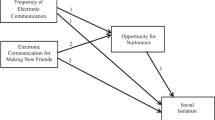Abstract
We identify subtypes of Venezuelan youth based on patterns of technology-based communication with friends in their receiving (US) and sending (Venezuela) countries and, in turn, examine the behavioral health characteristics among different “subtypes” of youth. Using data from 402 recently-arrived Venezuelan immigrant youth (ages 10–17), latent profile analysis and multinomial regression are employed to examine the relationships between technology-based communication and key outcomes. We identified a four-class solution: [#1] “Daily Contact in US, In Touch with Venezuela” (32%), [#2] “Daily Communication in Both Countries” (19%), [#3] “Weekly Contact: More Voice/Text Than Social Media” (35%), and [#4] “Infrequent Communication with US and Venezuela” (14%). Compared to Class #1, youth in Classes #2 and #3 report elevated depressive symptomatology and more permissive substance use views. Findings suggest that how youth navigate and maintain transnational connections varies substantially, and that technology-based communication is related to key post-migration outcomes.

Similar content being viewed by others
References
United Nations High Commissioner for Refugees (UNHCR): Refugees and migrants from Venezuela top 4million: UNHCR and IOM. 2019. https://www.unhcr.org/en-us/news/press/2019/6/5cfa2a4a4/refugees-migrants-venezuela-top-4-million-unhcr-iom.html. Accessed 20 Aug 2019.
United Nations International Children's Emergency Fund (UNICEF): Venezuela migrant crisis: 1.1 million children across the region will need assistance in 2019, up from nearly half a million today. 2019. https://www.unicef.org/press-releases/venezuela-migrant-crisis-11-million-children-across-region-will-need-assistance-2019. Accessed 20 Sept 2019.
Labrador, RC: The Venezuelan exodus. 2019. https://www.cfr.org/article/venezuelan-exodus. Accessed 10 Aug 2019.
United States Citizenship and Immigration Services (USCIS): Asylum division quarterly stakeholder meeting. 2019. https://www.uscis.gov/outreach/upcoming-national-engagements/outreach. Accessed 12 July 2019.
The Pew Research Center: Mobile fact sheet. 2019. https://www.pewinternet.org/fact-sheet/mobile/. Accessed 20 Sept 2019.
Silver, L, et al: Mobile Connectivity in Emerging Economies. 2019. www.pewinternet.org. Accessed 20 Sept 2019.
Jones C. ‘The cellphone does everything’: smartphones, internet access are key tools of 21st century migration. 2019. https://cronkitenews.azpbs.org/2019/04/30/venezuela-migrants-phones/. Accessed 20 Sept 2019.
Salas-Wright CP, Schwartz SJ. The study and prevention of alcohol and other drug misuse among migrants: toward a transnational theory of cultural stress. Int. J. Mental Health Addict. 2019;17:346–69.
Anderson M, Jiang J. Teens, social media & technology 2018. 2018. https://www.pewinternet.org/2018/05/31/teens-social-media-technology-2018/ . Accessed 20 Sept 2019.
Schwartz SJ, Salas-Wright CP, Perez-Gomez A, Mejia-Trujillo J, Brown EC, Montero-Zamora P, Meca A, Scaramutti C, Soares MH, Vos SR, Javakhishvili N. Cultural stress and psychological symptoms in recent Venezuelan immigrants to the United States and Colombia. Int J Intercult Relat. 2018;67:25–34.
Salas-Wright CP, Vaughn MG, Goings TC, Oh S, Marsiglia F, Cohen M, John R, Andrade P, Schwartz S. Disconcerting levels of alcohol use among Venezuelan immigrant adolescents in the United States. Addict Behav. 2020;104:106269.
Roberts C, et al. The Health Behaviour in School-aged Children (HBSC) study: methodological developments and current tensions. Int J Public Health. 2009;54(2):140–50.
De Looze M, van Dorsselaer S, Stevens GW, Boniel-Nissim M, Vieno A, Van den Eijnden RJ. The decline in adolescent substance use across Europe and North America in the early twenty-first century: a result of the digital revolution? Int J Public Health. 2019;64(2):229–40.
Lopez B, Wang W, Schwartz SJ, Prado G, Huang S, Brown CH, Pantin H, Szapocznik J. School, family, and peer factors and their association with substance use in Hispanic adolescents. J Primary Prevent. 2009;30(6):622–41.
Lasky P, et al. Developing an instrument for the assessment of family dynamics. West J Nurs Res. 1985;7(1):40–57.
Zimet GD, et al. The multidimensional scale of perceived social support. J Pers Assess. 1998;52(1):30–41.
Kroenke K, Spitzer RL. The PHQ-9: a new depression diagnostic and severity measure. Psychiatric Ann. 2002;32(9):509–15.
Hecht ML, et al. Culturally grounded substance use prevention: an evaluation of the keepin'it REAL curriculum. Prev Sci. 2003;4(4):233–48.
Kulis S, et al. Mexican/Mexican American adolescents and keepin'it REAL: an evidence-based substance use prevention program. Child Schools. 2005;27(3):133–45.
Vermunt JK, Magidson J. Upgrade manual for Latent GOLD 5.1. Belmont, MA: Statistical Innovations; 2016.
Celeux G, Soromenho G. An entropy criterion for assessing the number of clusters in a mixture model. J Classif. 1996;13:195–21212.
Funding
Research reported in this publication was supported by the National Institute on Drug Abuse of the National Institutes of Health under Award Numbers DA030310 and AA026645. The content is solely the responsibility of the authors and does not necessarily represent the official views of the National Institutes of Health.
Author information
Authors and Affiliations
Corresponding author
Ethics declarations
Conflict of interest
The authors declare that they have no conflict of interest.
Ethical Approval
All procedures performed in studies involving human participants were in accordance with the ethical standards of the Boston University IRB (protocol # 4993E) and with the 1964 Helsinki declaration and its later amendments or comparable ethical standards.
Informed Consent
Prior to participation, all youth provided informed assent and parents/guardians informed consent.
Additional information
Publisher's Note
Springer Nature remains neutral with regard to jurisdictional claims in published maps and institutional affiliations.
Rights and permissions
About this article
Cite this article
Salas-Wright, C.P., Vaughn, M.G., Goings, T.C. et al. Toward a Typology of Transnational Communication among Venezuelan Immigrant Youth: Implications for Behavioral Health. J Immigrant Minority Health 23, 1045–1052 (2021). https://doi.org/10.1007/s10903-020-01099-y
Accepted:
Published:
Issue Date:
DOI: https://doi.org/10.1007/s10903-020-01099-y




